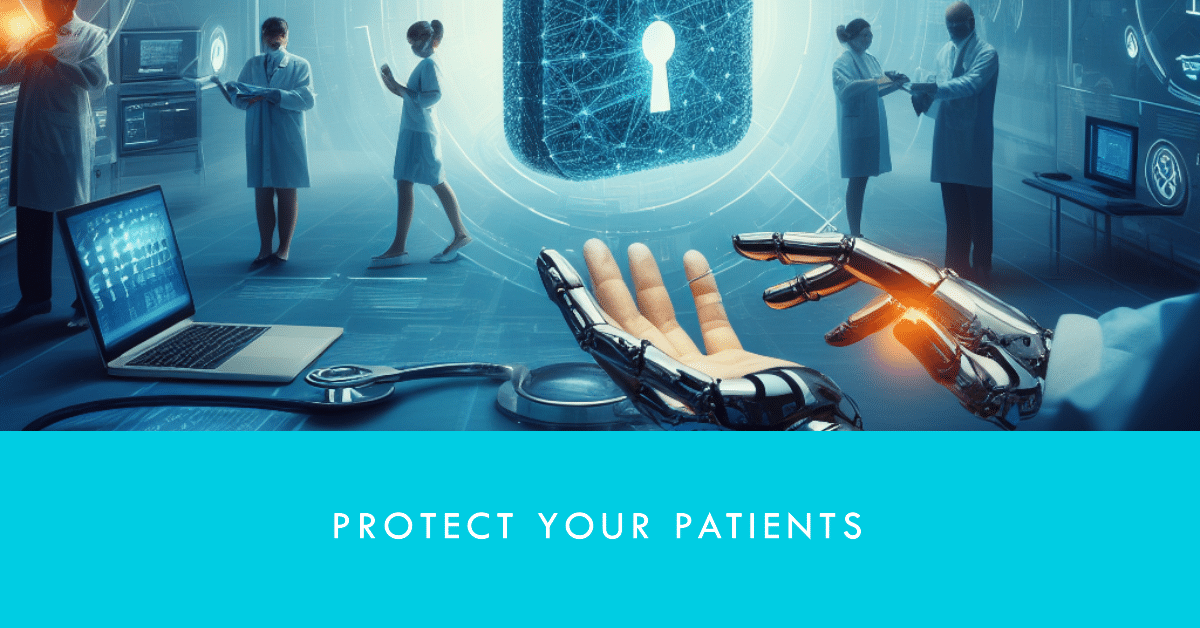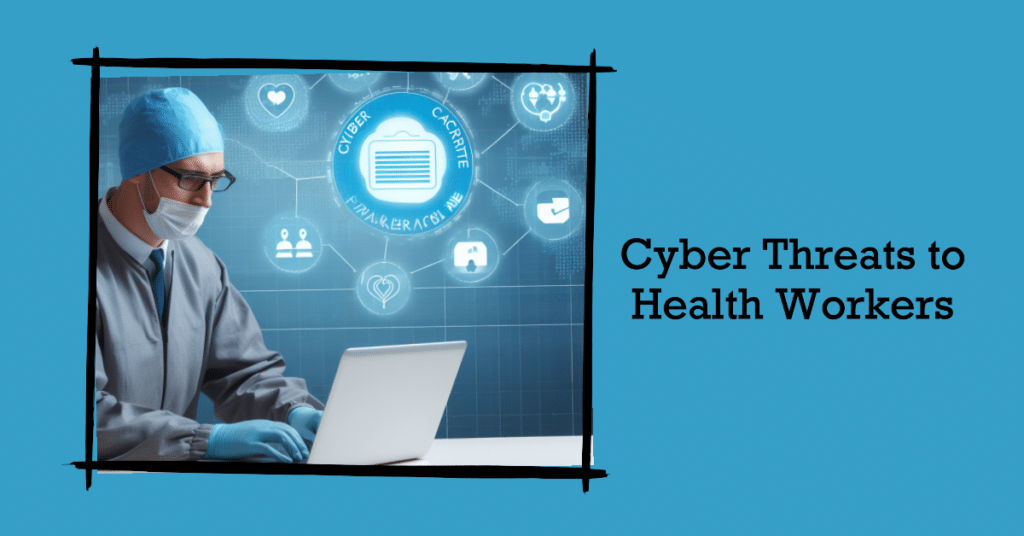How to Improve Cyber Security Awareness in Healthcare

The cost of cyberattacks to the UK healthcare sector is estimated to be in the billions of pounds each year (GOV.UK, 2023).
As technology use expands in healthcare, so does the risk of cyber attacks that can compromise sensitive data and disrupt operations. Yet many health workers remain unaware of the growing threats. This article explores practical ways to improve cybersecurity awareness and safeguard practices across your organisation.
While not overly technical, some basic understanding of online risks helps motivate staff to protect themselves and patients.
Let’s work together to create a human firewall!
Table of contents
Introducing the Cyber Security Risks in Healthcare
Before diving into cyber solutions, it helps to appreciate why healthcare has become a prime target for cyber attacks:
- Health records contain incredibly valuable and sensitive details prime for identity theft like SSNs, bank information, prescriptions, procedures, and treatment history.
- Stolen records fetch high prices on the dark web – far more than credit cards – given the potential for insurance fraud. Cybercriminals are drawn to these profits.
- Outdated IT systems and budget constraints leave many organisations more vulnerable to modern attacks like ransomware, phishing, and malware.
- Disruption of facilities by shutting down networks and devices directly impacts time-sensitive care. Lives could be at stake. This creates huge disruptive leverage.
- Sparse security expertise compared to other industries. Most clinicians lack cybersecurity training.
- Inconsistent security practices and lack of awareness among many health workers compared to financial or tech sectors.
As you can see, healthcare is an attractive soft target. But through education and vigilance, staff can dramatically improve protection.
Common Cyber threats that target healthcare organisations.
While cyber threats are always evolving, current top cyber risks to health organisations include:
- Phishing emails – Malicious links and attachments install malware, capture credentials, or access data if opened. Still one of the biggest risks due to human error.
- Ransomware – Malware that encrypts systems until a ransom is paid, crippling operations.
- Password practices – Weak or reused passwords allow credentials to be easily stolen, hacked, and misused.
- Medical devices – Connected devices and diagnostic equipment vulnerable to hijacking and manipulation.
- Cloud misconfigurations – Improper security settings enable breaches of cloud apps and servers.
- Unsecured WiFi – Allows attackers entry through open connections transmitting unencrypted data.
- Insufficient access controls – Overly broad access powers given through privilege misuse or lack of auditing.
- Lack of data encryption – Unencrypted data, files, and transmissions put confidential data at risk.
While technical measures are needed, human actions play a pivotal role in thwarting most attacks.

Cultivating a Cyber-Aware Workforce
Let’s explore impactful ways to promote more cyber-conscious practices at workplace:
1. Set Expectations Top-Down
- Make cyber security awareness training mandatory organisation-wide on a regular basis. Annual refreshers are key.
- Ensure leadership completes training first to reinforce importance from the top.
- Share real examples of cyber attacks on other healthcare organisations and the impacts.
- Publicise incidents internally (without details that could further breach trust) to reinforce constant vigilance is needed.
- Include basic security practices within health worker orientation processes. Start strong habits early.
2. Make it Engaging and Relevant
- Incorporate interesting real-world stories and examples that resonate instead of just dry policies.
- Tailor messaging and tips specific to roles – e.g. advice targeting doctors, nursing staff, or back-office. Different risks and protocols for each group.
- Partner with clinical champions from each department to reinforce messaging. Making it relatable.
- Use quizzes, games and team exercises to engage staff creatively in learning safe online behaviour.
- Offer small prizes to create friendly competition around cyber skills like detecting phishing emails.
3. Promote Speaking Up
- Train staff how to report concerning online activities, potential incidents and close calls without blame. Focus on learning.
- Develop clear and accessible procedures for confidential reporting of possible breaches, suspicious emails or malware.
- Provide multiple reporting channels including digital forms, email hotlines, an ethics portal, and in-person reporting.
- Ensure retaliation is strictly prohibited for those acting in good faith regarding potential issues.
4. Ongoing Vigilance
- Send routine fake phishing emails to see who needs retraining on spotting suspicious messages. Track improvements.
- Perform random spot checks of computing practices like password postings, file protections, suspicious downloads.
- Conduct simulated ransomware attacks to evaluate incident readiness and problem-solving.
- Monitor key performance indicators like training completion, phishing click rates, reported incidents.
- Have occasional cybersecurity stand downs to discuss latest threats, lessons learned, and brainstorm solutions.
Promoting a cyber-aware culture takes work but boosts readiness.
Creating a sense of shared responsibility for protection is key.
With creative engagement and leading by example, organisations can drastically strengthen human defences.
BUY NOW – CYBER SECURITY AWARENESS ONLINE TRAINING – CLICK HERE
Critical Security Tips for Doctors
Clinical users like doctors represent a major line of protection for healthcare organisations through their daily choices. Some key advice for physicians includes:
1. Use Strong Passwords
- Avoid weak passwords like ‘Password123’ or just ‘patient’ that are easily guessed.
- Never share passwords with others including admin staff. You are accountable.
- Change temporary passwords at first logins before accessing data.
- Don’t reuse passwords between systems or accounts. Compromise of one puts others at risk.
- Consider using a password manager app to securely create and store unique passwords.
2. Beware of Fake Emails and Messages (Phishing attempts)
- Be wary of emails asking you to click links or attachments to update details or resolve fake issues. Common phishing technique.
- Check the email address is truly from the organisation rather than a lookalike.
- Never enter your username and password on websites linked in emails. Manually navigate to legit sites.
- Report suspicious emails without responding for investigation by IT teams.
3. Protect Mobile Devices
- Password protect devices and enable encryption. Mobile theft could expose patient data.
- Only use trusted apps from official app stores to avoid malware.
- Enable remote wipe in case your device is lost or stolen.
- Avoid using unsecured public WiFi for sensitive tasks like accessing confidential data or emails.
4. Think Before You Click
- Never open email links or attachments from unknown people. This is a common malware tactic.
- Be extremely wary of social media messages resulting in clicking links, even if seemingly from connections. This is another infection bait hackers use.
- Confirm legitimacy with the sender via other methods first before clicking unexpected documents.
- You are the last line keeping patient data safe as you access and manage highly sensitive records. Staying vigilant against cyber ploys protects everyone. Speak up about concerning emails or activities you encounter at work. We’re in this together!
Practical Tips for Nurses to Improve Cyber Safety
Nurses handle sensitive patient information daily, making them a lynchpin for safeguarding privacy. Key advice for enhancing nurses’ cyber safety includes:
1. Only Access Authorised Data
- Never look up patient details like test results out of personal curiosity rather than clinical need. Breach of trust and possibly illegal. Follow the best data information safeguarding principles.
- Be careful not to access or modify the wrong patient record in the EHR system. Double check identifiers.
- Promptly log out of systems after use at public workstations to prevent access by others.
2. Secure Mobile Devices
- Never use text messaging for patient information due to lack of encryption.
- Only use approved secure apps for communication like WhatsApp or Signal. Standard SMS/text can expose data.
- Enable device locks to keep patient data secure if a mobile device is lost or stolen. Set to lock after several incorrect password attempts.
3. Handle Paper Records with Care
- Never remove physical patient charts and loose records from facilities.
- Securely shred and dispose of printed records with identifiable data.
- Keep printed papers safe and avoid leaving unattended in accessible areas.
4. Practice Caution with Email
- Avoid using patient names or medical details in email subjects, as email is not secure.
- Verify legitimacy before opening links and documents received via email. Common malware tactic.
- Report suspicious messages to IT for investigation rather than engaging with sender.
- You are the frontline stewards of incredibly sensitive patient information. Following secure practices keeps data protected both digitally and physically. We all play vital roles in the human firewall!
Simple But Effective Tips for Healthcare Assistants
While less involved in direct data entry, healthcare assistants still interact with confidential systems and paper records regularly. Some key tips include:
1. Only Use Authorised Systems
- Never access or attempt to log into clinical systems beyond your role. Data protection is everyone’s responsibility.
- Promptly log out of any system after use and don’t share access credentials.
- When assisting with system use, avoid watching screens as patient data may show. Give space.
2. Secure Passwords
- Avoid obvious passwords based on user IDs, locations or common words.
- Report any systems or software still using default passwords unchanged. Major risk.
- Don’t share passwords or badge codes with others or use lists. Report instead.
- If you write down passwords, keep securely locked away and destroy after memorising.
3. Handle Records Securely
- Keep patient records close to you when transporting and avoid unattended computers/tablets with data.
- Follow confidential disposal procedures for shredding patient information.
- Politely confirm identity when providing private patient details at desks or over the phone.
- No need for high-tech solutions. Simply being attentive every day promotes safety. Speak up right away if you notice any concerning practices or possible incidents. We protect patients better together.
BUY NOW- INFORMATION GOVERNANCE ONLINE TRAINING -CPD APPROVED – CLICK NOW

67% of healthcare organizations in the UK have experienced a cybersecurity incident in the past 12 months (Cyber Security Breaches Survey 2023).
Key Ways for IT Staff to Strengthen Healthcare Cybersecurity
For healthcare IT specialists, continuous improvement of technical defences is vital alongside fostering awareness.
Recommended high-impact actions include:
Patch, Patch, Patch
- Promptly install security patches, updates and new versions of operating systems, software and firmware. The majority of exploits target known fixed vulnerabilities. This means keeping your software up to date to protect against known threats.
- Automate system patching when possible, for efficiency. This means setting up automatic software updates to save time.
- Aggressively phase out end-of-life operating systems with solutions still receiving updates. This means that you should stop using outdated software that is no longer supported.
Utilise Multifactor Authentication
- Require a second step like biometrics, security keys or a verification code with every system login. This compensates for weak passwords.
- Prioritise MFA for infrastructure like VPNs, remote access, email, and EHR logins. These access points are juicy targets.
Improve Visibility
- Implement a security information event management (SIEM) system for centralised logging, monitoring and correlation of network activity.
- Collect and analyse unified data feeds from web gateways, firewalls, endpoints, servers, etc. to identify anomalies indicating threats.
- Use analytics tools to baseline “normal” traffic and trigger alerts for significant deviation that could represent attacks.
Test Defences
- Routinely penetration test systems by simulating attacks to uncover gaps. Ethical hacking services help significantly.
- Run simulated phishing campaigns internally to improve email threat detection skills.
- Conduct remediation planning exercises for major incidents like ransomware attacks.
As healthcare technology footprint increases, proactive protection must keep pace. Leverage solutions that compensate for inherent staff limitations around cybersecurity.
Technical controls and training combine for comprehensive defence.

The cost of cyberattacks to the UK healthcare sector is estimated to be in the billions of pounds each year (GOV.UK, 2023).
BUY NOW – CYBER SECURITY AWARENESS ONLINE TRAINING – CPD APPROVED
Creating a Cyber-Conscious Healthcare Culture
While we’ve covered key groups, fostering widespread cybersecurity awareness throughout healthcare organisations requires an integrated strategy including:
- Annual cybersecurity training mandated for all staff from leadership to frontline. Updates on emerging threats and high-risk activities.
- Department level discussions on tailoring protocols and vigilance to role-specific risks. Engages staff in solutions.
- Prominent awareness posters and digital signage about reporting suspicious activity. Removes barriers.
- Random simulated phishing emails sent to gauge susceptibility and need for additional role training. Track progress over time.
- Promoting cyber-aware mindsets starting day one through orientation activities.
- Developing formal protocols for confidential reporting of concerns, near misses, or suspected incidents.
- Gathering staff input on challenges, ongoing problems, and improvement ideas. Crowdsource solutions.
- Sharing incident learnings internally (in general terms) that resonate to reinforce collective responsibility.
- Public recognition of vigilance stars who proactively report close calls and concerning activity.
While challenges exist, transforming healthcare cybersecurity is achievable through creativity, cross-department collaboration, and persistence.
Protecting patients and staff from evolving threats demands constant learning and adapting together. This begins with laying a foundation of greater collective understanding about the risks in healthcare’s digital transformation.
Progress takes commitment but is fully within reach if we each play our part in the human firewall.
Cyber Security FAQs in Healthcare
Cybersecurity in healthcare is like a protective shield for our digital systems.
It helps keep patient information, such as medical records and personal details, safe from cyber threats like hackers.
By having strong cybersecurity measures, we ensure the confidentiality, integrity, and availability of crucial healthcare data.
In the NHS, cybersecurity is vital to safeguard patient information and maintain the smooth functioning of healthcare services.
It prevents unauthorized access to sensitive data, protects against potential cyber attacks, and ensures that patient care remains uninterrupted and secure.
To promote cybersecurity awareness, we can conduct regular training sessions for healthcare staff.
These sessions will focus on simple and practical steps to identify and avoid potential threats.
Additionally, using real-life examples of cyber attacks and their consequences can help raise awareness and encourage a proactive approach to security.
Cybersecurity awareness is crucial because it empowers healthcare workers to recognise and address potential threats.
Being aware of cybersecurity risks ensures that personal and patient information is kept safe, maintaining trust in healthcare services and preventing disruptions to patient care.
Common cyber attacks in healthcare include phishing emails, ransomware, and malware.
Phishing involves tricking individuals into revealing sensitive information, while ransomware encrypts data until a ransom is paid.
Malware, a broader term, includes various types of malicious software aimed at disrupting or gaining unauthorized access to systems.
The three main goals of cybersecurity are to protect confidentiality, maintain the integrity of data, and ensure the availability of essential information.
These goals work together to create a secure environment where sensitive data is kept confidential, data accuracy is preserved, and information is readily accessible when needed.
Let us Help you
We’ll help you find the right course for your needs. Tell us a little bit about your situation and what you would like to achieve.
We’ll get back to you within one working day.
